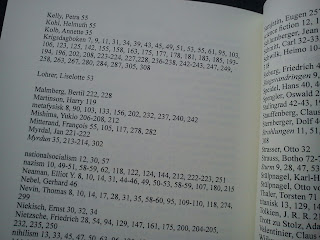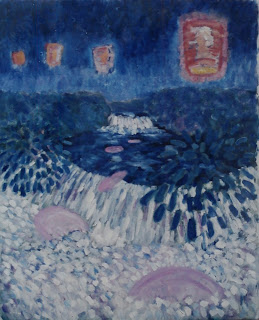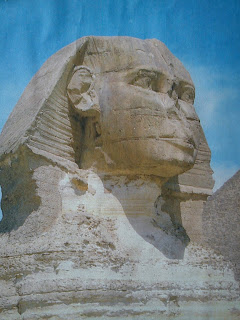1. Två sf-romaner
Bertil Mårtensson var en svensk fantastik-författare. Han levde 1945-2018. I mångt och mycket är han min favorit som svensk sf-person. När han var bra, då var han bra. Men han hade också sina brister.
Bilden som illustrerar detta inlägg visar romanen Samarkand 5617 (1976). Den kan stå som symbol för när Mårtensson inte riktigt övertygar. Denna bok må vara en nämnvärd uppvisning av en genre- och stilmedveten författare. Men att riktigt läsa och underhållas av den, se det är en annan sak... Romanens intrig är krånglig. Det hela utspelas på den avlägsna planeten Vilahall där diverse svårförklarliga saker händer. Detta är kruxet: man sitter som läsare hela tiden och gissar sig fram, man famlar liksom i blindo.
Denna bok må vara seriös och aktningsvärd. Stilen i sig är klar och transparent. Men intrigens komplexitet kräver antagligen flera genomläsningar innan man fattar galoppen.
Ska man läsa en sf-roman av Mårtensson där man åtminstone inte behöver gissa gåtor hela tiden är Jungfrulig planet (1977) bättre. Upplägget är inte så originellt (imperialistisk rovdrift hejdas av heroisk planetekolog) men utförandet är ganska snitsigt. Det är en galaktisk intrig, en främmande planet, rymdsamhällets vardag och rätt bra tecknade karaktärer därtill.
Intrigen i korthet: Ekologen Sefrem Ibrahim åker till planeten Batak för intriger och annat hejsan. Världarnas Förbund (= VF) är hans hårde uppdragsgivare – men förmår han sätta hårt mot hårt? Eller vill han bara rulla runt i sänghalmen med Katten och Namiko Wrede?
Detta får i stort sett räcka om BM som romanförfattare. Mer om hans sf-romaner här, mer om hans fantasyroman här.
2. Novellisten Mårtensson
Vi går över till några nämnvärda noveller i sammanhanget.
I Nova SF hade BM ett flertal noveller. Fotot på den krumme figuren som ser en katedral i skyn är från Flygande katedraler i 3/1983. Som ofta i BM-sammanhang är det en huvudperson det är lite synd om. Denne figur finns där liksom alltid: dåren, den halvt misslyckade, ”the odd man out”. Det kan bli lite känslomanipulativt (man förutsätts automatisk stå på denne figurs sida i hans strävanden i en hård värld) men så är det förvisso hos BM, detta inslag finns så gott som alltid i hans berättelser: stackaren är i fokus. Om någon däremot är framgångsrik ses denne som suspekt.
I ”Flygande katedraler” heter stackaren Jormas Alruna. I en galaktisk framtid finner han efter ett tag sin plats som orgeltrampare hos en kantor. Snart lär han sig spela orgel själv. -- Därtill styrs denna novell av djärva visioner. Ty rymdskeppen i denna kultur drivs av musik; i katedralformade skepp är det organisten som styr. Detta är en helt bedövande läcker idé; det är musisk människa, sfärernas musik, till oändligheten på en Bach-melodi... Blotta idén med musikaliskt drivna rymdskepp hör till det bästa som BM åstadkom. Han kunde själv spela instrument och han hade sin stilistiska talang som författare, och i denna novell förenas allt till tidlös konst.
En annan bra Nova-novell av BM var Rock & Roll och marsianer (2/1982). Titeln låter kitschig och ”down-market” men det är en rätt övertygande sak om fluktuerande verklighet. Därtill med moraliserande över spritens skadeverkningar; det sista är en rätt obetydlig detalj men som fenomen intressant. Ty i detta ämne kan vi hos den i regel avspände och urbane BM ändå skymta en hart när puritansk hängivenhet, den om att påpeka det farliga i att dricka sprit.
Ännu en novell av BM som är nämnvärd är Det sista galaktiska kriget (först publicerad i Teknikmagasinet 3/1985, sedan i Nova 6/2005). Den kan beskrivas som en variant av Dicks Time Out of Joint, här med det Mårtenssonska subtemat som är “det är synd om författare”; alltid ska det vara denne stackare i huvudrollen... Men med det sagt så är denna text ändå en rätt snitsig sak på (återigen) temat fluktuerande verklighet.
3. Tragiken, funkar den...?
1986 gavs Ellerströms ut en booklet med tre Mårtensson-noveller, Förvandlas. Jag fokuserar här på en av texterna, Drömmen om jorden.
I en avlägsen framtid åker en grupp på turistresa till jorden. De ser ståtliga traditionella miljöer (New York, London osv.). Men människor finns ej ty de lämnade jorden på 2000-talet pga. miljöförstöring och radioaktiv besmittelse. Bara en människospillra finns kvar, han som guidat gruppen. – Twisten är att detta är tragik, djup tragik. Och funkar det? – Tragik i sf är ett svårt mål att uppnå. Öht. i litteratur är tragik en svår konst; hur ska man då lyckas med det i en egenartad genre som sf – en genre som ju lånar sig till mycket annat såsom idédiskussion.
Det var inte för tragikens skull jag började läsa sf. Det var istället för att serveras ”omöjliga äventyr”, äventyr som trotsade vardagens grå. Det var för att bjudas sinnesutvidgande idéer; det var för att erbjudas alternativa verkligheter, nya angreppsvinklar. Att i denna mix komma dragande med att det också bjuds tragik är lite missriktat. Därför är jag skeptisk till novellen Drömmen om jorden – jag menar, visst är en rapsodi, även en seriös rapsodi över jordens historia i novellform, lovvärt som sf-idé. Men att sedan slänga in dårhus-pessimismen (= jorden förgiftades och människan lämnade den, en kliché i dåtida sf) och antyda att detta är tragik i högsta potens – det rockar inte för mig.
Förvandlas är 62 sidor seriös sf signerad BM, ambitiös och med ställvis lätt handlag, men konceptuellt är detta inget för actionisten.
4. Aspekter
Steve Sem-Sandberg är en rätt nybliven akademimedlem. En gång i tiden skrev han sf. Resultatet ser man bl.a i den samling han och BM gav ut en gång, Vilse (1979). Vi förbigår SSS’ fantastik här, ja för övrigt hela SSS’ prosakonst, och koncentrerar oss på den BM som var hans parhäst i Vilse. Ty i denna bok övertygar skåningen här och där med sina alster. Såsom i Benedictus sällsamma himmelsfärd, där en människa förvandlas, höjer sig andligt – och blir en stjärna. Bokstavligt.
Det är övertygande, även ur ett esoteriskt perspektiv. Stjärnorna lever; alla har sin ande. Såsom Uriel i Paradise Lost. Och här i BM:s novell var det alltså en människa som eleverade sig mentalt till en sådan stellar spirit.
Ett nämnvärt verk av BM i Vilse är även Kvinna med diadem, om musikens makt att skapa verklighet. Det handlar om ett musikintresserat berättarjag, som ute på en skärgårdsö träffar ett geni och dennes experiment – med datorer och musik. Geniet heter Peter Gård och det hela utvecklas dramatiskt. Med alla sina uppslag och attityder är denna text som en hel roman på sina blott 16 sidor; det är en episk novell.
I denna samling finns ett och annat, såsom BM:s bibliografiskt andra publicerade novell, nämligen Femte resan. Den kördes först i Häpna 2/1964 (debuten var i samma magasin med Urhemmet, 12/1963). Vad gäller Femte resan så är det psykologiskt tung-gung i ensam rymdfärd; tonen är pessimistisk och huvudpersonen är, hm, inte ”actionist” om ni fattar.
Mårtenssons generella fel var möjligen detta: att han var för seriös-pretentiös. Ungefär som Poul Anderson. Eller Ursula Le Guin. Dvs: alla dessa skribenter hade nog förmågan att skriva rak, underhållande fantastik. Men alltför ofta lockades de att istället skriva Stor, Odödlig Litteratur. Och visst, det finns sf-klassiker med tragik och djup. Men att alltid försöka höja sig till Den Odödliga Konstens domäner, det sätter hämsko på kreativiteten, det riskerar att göra texten stel och livlös.
Mårtensson har alltså skrivit en fantasyroman där ”allt stämmer”, Maktens vägar del 1. Här, anser jag, är den grundläggande attityden lekfull. Visst finns ett tema om maktkamp mm. men hela den struktur författaren här skapat åt sig medger oändliga möjligheter till fablande, prosapoesi, påfund och hugskott.
Så i denna episka fantasyform frodas han. I sf:en var han generellt lite stelare. Men se, det finns ett sätt att låta denna översikt utmynna i en positiv ton. För i sina kassettfanzines kunde han ha ovan antydda lekfulla attityd och triumfera – även i berättande, även i sf-epikens förtrollade värld...!
Det kan vara så att ”kassettfanzinet Ogre” inte hör till BM:s hävdvunna bibliografi. Eller diskografi. Men i de ex av Ogre jag äger finns å andra sidan ingen brasklapp som förbjuder mig att granska dem; därför måste jag ta med dem i denna kritiska översikt över BM:s författarskap.
Ogre började på 60-talet som ett pappersfanzine. Sedan, kanske från och med nr 6, kom det på kassett. Ville man ha ett ex sände man en tom kassett till BM; så kopierade han verket till det och man fick det hela i retur.
5. Musikern BM
Ogre 6 från tidigt 80-tal är förstås en salig blandning av ”fanniska upptåg” och ”BM leker med gitarren”. Men han kunde iaf. spela, både gitarr och dragspel, senare även synt. Och litterärt finns här en del. Såsom parodiska dikter; han kunde både dikta och deklamera dem; hans diktion är perfekt. Det är inte alla som har ”radioröst”. Jag ska inte citera något, men det vill jag ha sagt: lekfullhet hos en i övrigt seriös författare är det yttersta tecknet på mästerskap. ”Vill du se en mans sanna natur, betrakta honom då han leker” sa ju Goethe. Och svenska författare som även kunde skriva skämtdikter var för sin del Södergran, Heidenstam, Lindegren...
Ogre 6 har därtill en parodisk novell som BM läser upp: Möte i rymden, om en malmletande rymdman som blir galen i rymdens ensamhet. Hotet kommer i form av dragspel... som multimedia-verk (text, musik) är detta slående bra. BM kunde berätta både i skriven text och i ”spoken word”; diktionen, anslaget, tight-but-loose... mästerligt. Denna berättelse låter spontan men jag hävdar, utan bevis, att han läste efter manus.
Det totala mästerverket i denna genre var Ogre 8, med en hel rymdopera av BM: all musik var original, han uppförde den själv och berättade allt själv. Fingals fjäril heter opuset. På 90 minuter får man ouvertyr och tre akter (plus intermezzo), på temat en rymdmans sökande efter en försvunnen planet. Det visar sig att på planeten bor en rymdpirat som håller en kålmask fången; Fingal sätter sig i sinnet att befria denna mask.
Det hela är en parodisk historia men det känns ändå äkta. Jag dristar mig att säga: detta är tidlöst. Man bjuds BM:s berättande i ord vartill man får en diskret ljudmålning i bakgrunden, och man bjuds inskjutna sångnummer, dvs. ”arior” även om det förstås inte är symfoniska arior. Men ouvertyren är lätt symfonisk! – BM:s multitalang (ord och toner) förenas här i ett högre amalgam. Därtill finns moralismen också; att befria kålmasken så att denna kan bli, ni gissar det, fjäril, blir föremål för en stillsam moralisk lektion av typiskt BM-slag. Men man får kapitulera; allt spelar här med i helheten, även söndagsskolemoralen.
Även i Ogre 10: Invasion bjöds man på ett sf-äventyr. Berättelsen interfolieras av repriser ur BM:s musikproduktion, så kallade filksonger som jag kan vara utan (en filksong är en ”fannisk folksång”, en traditionell sång man ändrar texten på för att skoja till det på temat ”sf-fansens liv och leverne”). Så är det med Ogre 10: Invasion, här är det en myckenhet daterad filksongskultur – men kärnan i det hela, berättelsen som är ramverk, är lekfull, väl uppläst och ”spontan men ändå förberedd” – dvs. han läser ur manus. Men som Ingmar Bergman sa, endast den förberedde kan improvisera. Endast med en struktur som stöd kan man som konstnär känna sig fri.
6. Personliga hågkomster
Jag skulle kunna nämna mer om BM -- mycket mer. En i så fall enkel sak att nämna är hans deckare, av vilka jag inte läst någon. Men Jan Erelius’ äventyr ska visst ha varit inspiration för Mankells Wallander: gråväders-krimi i Skåne... så nu vet ni det.
I min privata mytologi framtonar BM rätt skarpt. Jag träffade honom IRL gång, på SweCon 83 i december 1983. Då hade vi redan brevväxlat en del; jag hade fått Ogre 6-8 och njutit av dem, och jag hade läst Maktens vägar 1 & 2, och sedan hade han fått de fanzines jag då börjat ge ut. Så vi kunde där i Villa Kaprifol prata lite löst om musik, bl.a om jazz. BM var en chosefri, trankil typ, lättpratad och tillgänglig.
Detta var enda IRL-mötet. Men vi upprätthöll en viss brevkontakt även framdeles, såsom att jag sände honom fanzines och fick kassettfanzines i retur. Såsom Munkarna i Toypé, ett meditativt syntverk, någonstans i skärningspunkten mellan Ralph Lundsten och Kitharo. Inramningen (kassettverk) är blygsam men konstnärligt är detta new age-musik av bästa sort.
BM:s musik förgyller, liksom i ett återsken, hela hans verk. Lättheten och lekfullheten på kassett skapar ännu en dimension till hans rent litterära verk. Det må vara att lekfullheten ibland fanns även i text (Dummast i universum, Nova 1/1985) och då körde i diket... nåja. BM:s hela opus har en musisk grundton; när allt stämmer, när moral, intrig, målerisk förmåga etc. underordnas helheten så står vi inför konstverk med odödligt, tidlöst skimmer, såsom Maktens vägar 1, Flygande katedraler och, jodå, Fingals fjäril.
Coda
BM var verksam som akademisk fackfilosof. Hans credo var ”reduktionistisk vetenskap”; det var inte esoteriskt-andligt. Det var skolfilosofiskt. Jag måste ibland påminna mig själv om det, eftersom jag har en förmåga att läsa in lite för mycket i hans gestalt. BM framstår ofta för mig som ”arketypisk författare typ 1A”... och då har jag även en tendens att se honom som ”den gamle vise mannen”. Nu har jag en annorlunda tro än skolfilosofisk reduktionism, mycket annorlunda... men med det sagt, när BM gör filosofiska anmärkningar så sker det ibland med ironisk attityd och musisk lätthet (såsom i hans bokrecensioner).
Ska man gå en kurs i rent akademisk vetenskapsteori, från Platon till Popper, vore BM en bra lärare. Han var beläst, och inte bara i vetenskapligt hänseende; troende var han inte men han hade läst Bibeln, det märks här och där; litterärt hade han absorberat något av detta verk. ”I Bibeln står det, att man ska ge, ej ta...” är en rad ur en filksong som fastnat; det är bara ett exempel. En glimt ur ett beläst sinne kallar jag det. BM kunde med musisk lätthet foga in traditionell konst och litteratur i sitt verk.
Slutkläm: BM kunde komponera många sorters musik, ja även popsånger. Här är inte platsen att prisa honom som popkung – men – visst var låtar som Slow Down och Morgonsång nämnvärda i denna genre. Och från den sistnämnda citerar jag nu en del av texten – ty detta är för mig BM i ett nötskal, ironisk men ändå seriös, allt med stilmässigt välbehag. Det är en amorös episod i den äkta sängen, kan man säga:
Du ligger vid min sida, när jag ser dig är jag nöjd,
med kärleken du skänker mig en tröst.
Jag drar mitt svärd ur skida, för vår kärlek är jag böjd,
åt mina känslor måste jag ge röst...
Relaterat
BM recenserar böcker
Maktens vägar
Mårtenssons sf
Nova SF


























